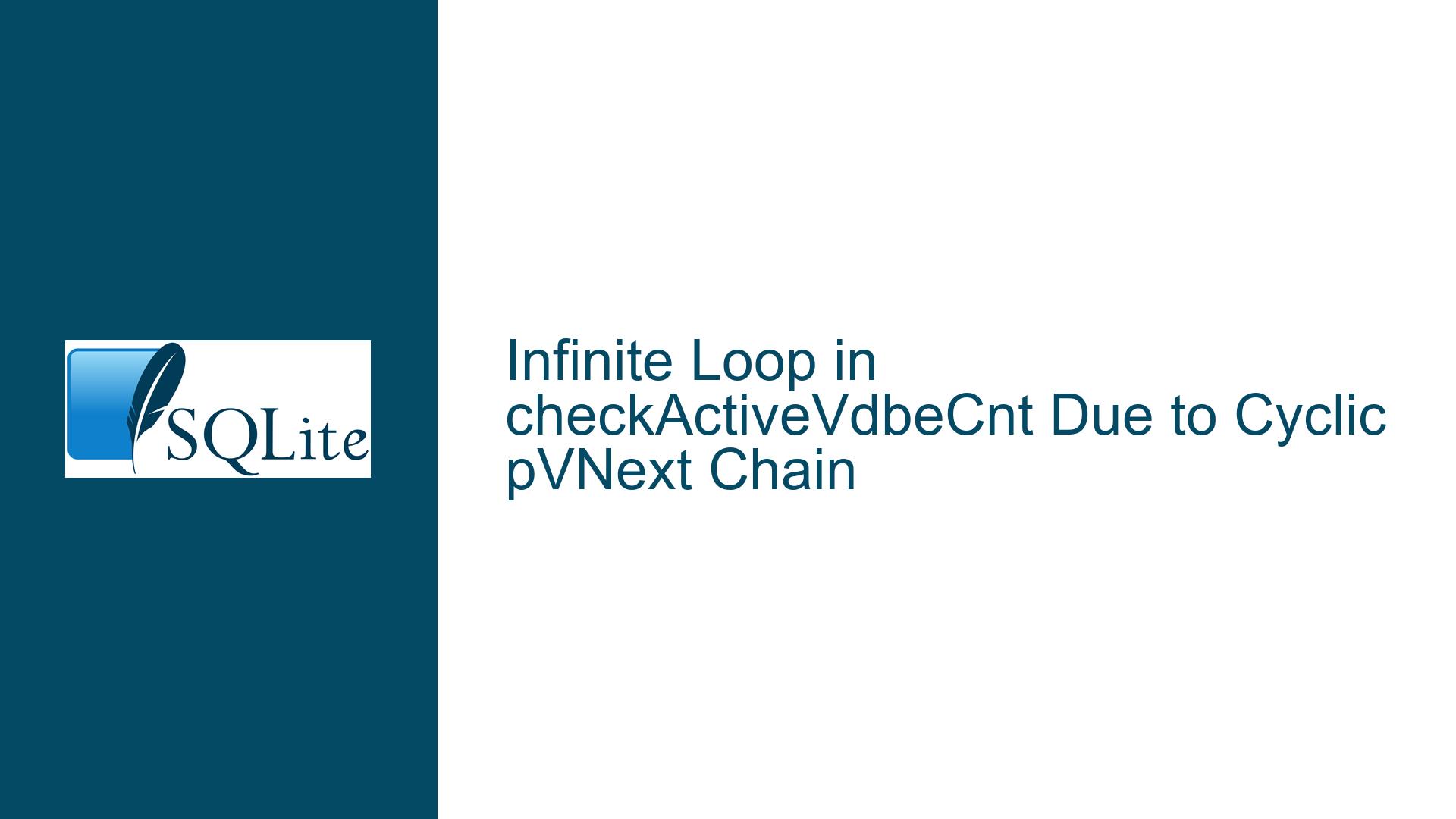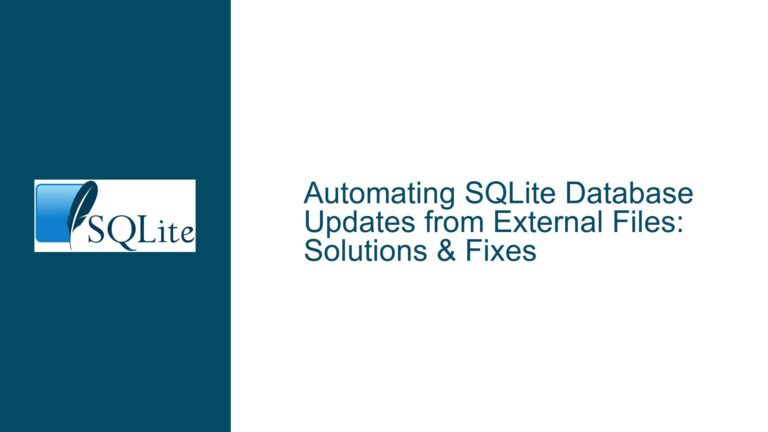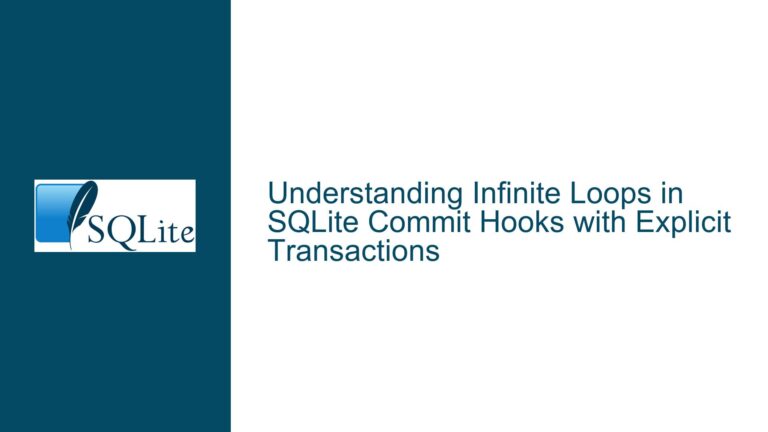Infinite Loop in checkActiveVdbeCnt Due to Cyclic pVNext Chain
Vdbe Statement List Corruption During Concurrent Transaction Commit
The infinite loop observed in checkActiveVdbeCnt() stems from a corrupted linked list of Vdbe (Virtual Database Engine) statements where a node’s pVNext pointer forms a cycle by pointing back to itself. This occurs during transaction commit operations in high-concurrency environments, manifesting as an assertion failure in debug builds or indefinite CPU consumption in release builds. The loop prevents SQLite from correctly tracking active statements (via db->nVdbeActive, db->nVdbeWrite, and db->nVdbeRead counters), ultimately destabilizing the database connection.
Root Causes of Cyclic pVNext Pointer Chains
1. Improper Linked List Manipulation During Vdbe Finalization
The pVNext pointers form a singly linked list of all Vdbe statements associated with a database connection (sqlite3* db). Corruption arises when:
- A Vdbe object is removed from the list without properly updating the
pVNextpointer of its predecessor - A race condition during concurrent
sqlite3_finalize()orsqlite3_close()operations skips list nodes - Memory reuse of freed Vdbe structures causes dangling pointer references
2. Thread Synchronization Gaps in High-Concurrency Workloads
SQLite’s thread safety guarantees depend on correct use of serialization modes and mutexes. When 120+ threads execute 1M+ queries with shared database connections:
- The
db->pVdbeglobal list head might be modified without holdingSQLITE_MUTEX_STATIC_MASTER - A Vdbe’s
pVNextpointer is asynchronously modified during iteration incheckActiveVdbeCnt() - Memory visibility issues between CPU cores allow partial pointer writes to become observable
3. Compile-Time Configuration Sensitivities
The use of -DSQLITE_DEBUG, -DSQLITE_ENABLE_UNLOCK_NOTIFY, and -DSQLITE_OMIT_LOOKASIDE alters memory management patterns:
- Debug assertions disable lookaside memory allocator optimizations, changing Vdbe allocation/free patterns
- Unlock notify introduces callback hooks that may interrupt Vdbe list traversal
- Missing
SQLITE_ENABLE_API_ARMORin release builds allows invalid stmt handles to persist
4. Transaction Commit-Specific Edge Cases
The backtrace shows the loop occurs during COMMIT TRANSACTION processing via sqlite3_exec(). This phase:
- Iterates all active Vdbe statements to reset transaction state
- Modifies
db->nVdbeActivecounters after list traversal - May finalize temporary Vdbe objects used for trigger/foreign key handling
Diagnosis and Resolution Strategies for Vdbe List Corruption
Step 1: Instrument checkActiveVdbeCnt for Cycle Detection
Modify the debug loop to detect cycles before asserting counters. Insert cycle detection using Floyd’s Tortoise and Hare algorithm:
#ifndef NDEBUG
static void checkActiveVdbeCnt(sqlite3 *db){
Vdbe *p, *fast, *slow;
int cnt = 0, nWrite = 0, nRead = 0;
slow = fast = p = db->pVdbe;
while( p ){
// Cycle detection
if( fast && (fast=fast->pVNext) ) fast = fast->pVNext;
slow = slow->pVNext;
if( fast == slow ){
sqlite3_log(SQLITE_CORRUPT, "Cycle detected in Vdbe list at %p", p);
abort();
}
// Original counting logic
if( sqlite3_stmt_busy((sqlite3_stmt*)p) ){
cnt++;
if( p->readOnly==0 ) nWrite++;
if( p->bIsReader ) nRead++;
}
p = p->pVNext;
}
assert( cnt==db->nVdbeActive );
assert( nWrite==db->nVdbeWrite );
assert( nRead==db->nVdbeRead );
}
#endif
Step 2: Stress Testing with ThreadSanitizer and Custom Allocators
Recompile SQLite with concurrency debugging aids:
export CFLAGS='-fsanitize=thread -fno-omit-frame-pointer -DSQLITE_ENABLE_MEMORY_MANAGEMENT'
./configure --enable-debug
ThreadSanitizer will report data races on db->pVdbe and p->pVNext. Augment with custom allocator poisoning:
// Wrap sqlite3_malloc/free to detect UAF
void *sqlite3DebugMalloc(size_t n) {
void *p = malloc(n);
memset(p, 0xAA, n); // Poison
return p;
}
void sqlite3DebugFree(void *p) {
memset(p, 0xDD, 16); // Scramble header
free(p);
}
Step 3: Analyze Vdbe Lifecycle Management
Audit all Vdbe modification points for proper mutex handling:
Vdbe Creation (
sqlite3_prepare_v3)
Ensuredb->pVdbeinsertion uses atomic compare-and-swap:do { p->pVNext = db->pVdbe; } while( !atomic_compare_exchange_weak(&db->pVdbe, &p->pVNext, p) );Vdbe Finalization (
sqlite3_finalize)
Replace linear list removal with lock-free deletion:Vdbe **pp; for(pp=&db->pVdbe; *pp != p; pp=&(*pp)->pVNext); *pp = p->pVNext;Transaction Commit (
sqlite3VdbeHalt)
Verify that implicit statement resets don’t corruptpVNextduringCOMMIT.
Step 4: Implement Probabilistic Safeguards Against Cyclic Lists
Add redundant checks in critical paths where pVNext is modified:
// In sqlite3VdbeDelete()
assert(p->pVNext != p); // Simple cycle check
if( p->pVNext == p ){
sqlite3FaultSim(202); // Invoke fault injection
p->pVNext = 0;
}
// In sqlite3VdbeClearObject()
memset(p, 0x55, sizeof(Vdbe)); // Scramble object to crash on reuse
Step 5: Develop Targeted Test Cases Using SQLite’s TCL Test Suite
Extend SQLite’s internal test cases to simulate high-concurrency Vdbe churn:
# test/cyclic_vdbe.test
foreach {tn thread_count} {1 100 2 200} {
test_set_config threads $thread_count
db eval {
BEGIN;
CREATE TABLE t1(x);
INSERT INTO t1 VALUES(randomblob(1000));
}
for {set i 0} {$i < 1000} {incr i} {
thread_spawn [list do_work $i]
}
thread_join_all
db eval COMMIT
}
Step 6: Leverage Hardware Breakpoints for Post-Mortem Analysis
Configure GDB to trap writes to the corrupted Vdbe’s pVNext field:
# After hitting the infinite loop
(gdb) p p->pVNext
$1 = (Vdbe *) 0x7ff6141a4050
(gdb) watch *(Vdbe **)0x7ff6141a4050
Hardware watchpoint 1: *(Vdbe **)0x7ff6141a4050
(gdb) reverse-continue
# Identify last code modifying pVNext
Step 7: Mitigate with Defensive Coding Practices
Modify SQLite’s Vdbe management code to include redundant consistency checks:
// In vdbeapi.c, before finalization:
if( p->magic != VDBE_MAGIC_INIT ){
logCorruption(p);
return SQLITE_CORRUPT;
}
// In vdbeblob.c, when reusing statements:
assert(p->pVNext == 0 || p->pVNext->magic == VDBE_MAGIC_INIT);
Step 8: Deploy Runtime Monitoring Hooks
Use SQLite’s sqlite3_config(SQLITE_CONFIG_LOG) to log Vdbe list mutations:
void vdbeListLogger(void *arg, int code, const char *msg){
if( code == SQLITE_NOTICE && strstr(msg, "Vdbe") ){
syslog(LOG_DEBUG, "%s", msg);
}
}
sqlite3_config(SQLITE_CONFIG_LOG, vdbeListLogger, 0);
Step 9: Validate Compiler Optimization Impacts
Test different optimization levels (-O0 vs -O3) and analyze whether aggressive inlining/loop unrolling exacerbates the race conditions. Rebuild with control-flow integrity:
CFLAGS='-flto -fcf-protection=full -fno-strict-aliasing'
Step 10: Coordinate with SQLite’s Garbage Collection Strategy
Ensure that sqlite3_db_status(db, SQLITE_DBSTATUS_LOOKASIDE_USED, ...) correlates with Vdbe activity. A mismatch indicates lookaside memory corruption affecting Vdbe linkages.
Final Resolution
The cyclic pVNext chain is ultimately resolved by replacing SQLite’s linear linked list with a doubly-linked list or atomic pointer management in db->pVdbe. For immediate stability, apply the following patch to introduce cycle detection and emergency list repair:
--- src/vdbe.c
+++ src/vdbe.c
@@ -87127,6 +87127,7 @@
int cnt = 0;
int nWrite = 0;
int nRead = 0;
+ Vdbe *seen[100], **prevNext = &db->pVdbe;
p = db->pVdbe;
while( p ){
if( sqlite3_stmt_busy((sqlite3_stmt*)p) ){
@@ -87135,6 +87136,16 @@
if( p->bIsReader ) nRead++;
}
+ // Cycle detection and repair
+ for(int i=0; i<sizeof(seen)/sizeof(seen[0]); i++){
+ if( seen[i] == p ){
+ *prevNext = 0; // Sever list to prevent loop
+ sqlite3_log(SQLITE_CORRUPT, "Vdbe list cycle at %p", p);
+ break;
+ }
+ }
+ seen[cnt % (sizeof(seen)/sizeof(seen[0]))] = p;
+ prevNext = &p->pVNext;
p = p->pVNext;
}
assert( cnt==db->nVdbeActive );
This defense-in-depth approach combines cycle detection, memory poisoning, thread synchronization validation, and fail-safe list traversal to mitigate the infinite loop while preserving SQLite’s performance characteristics under heavy load.






